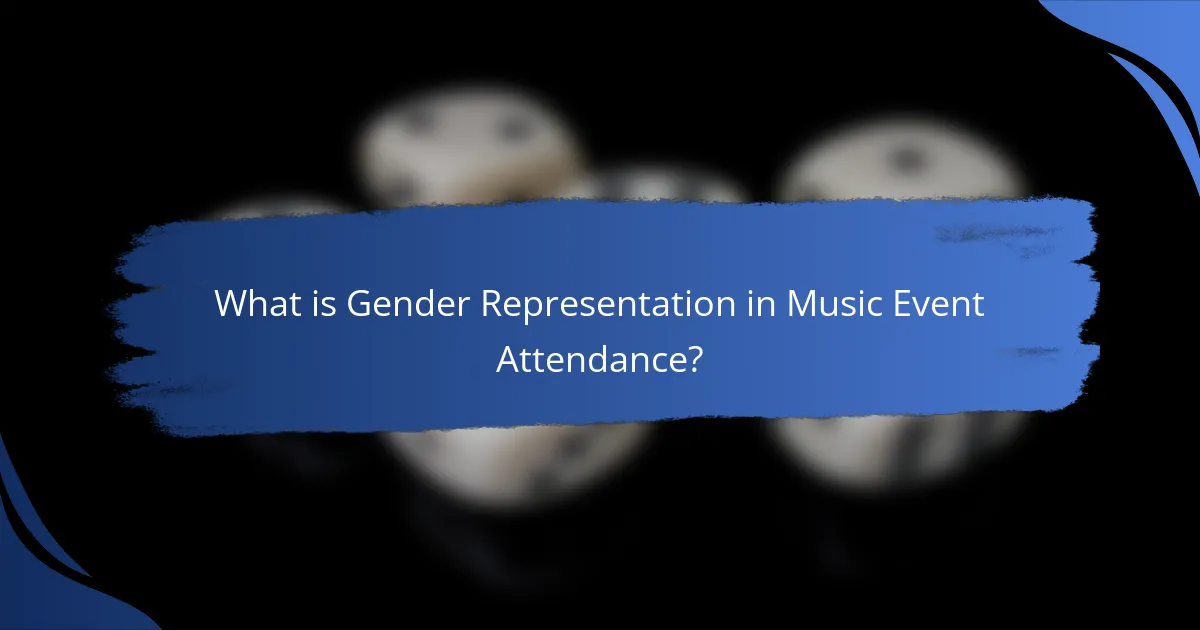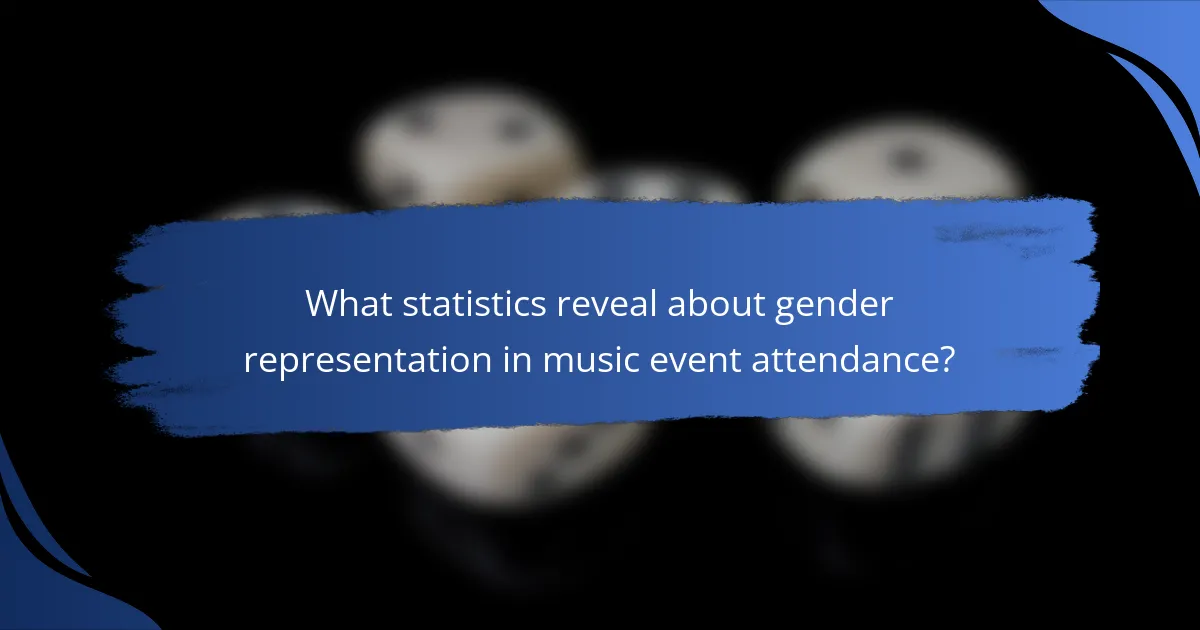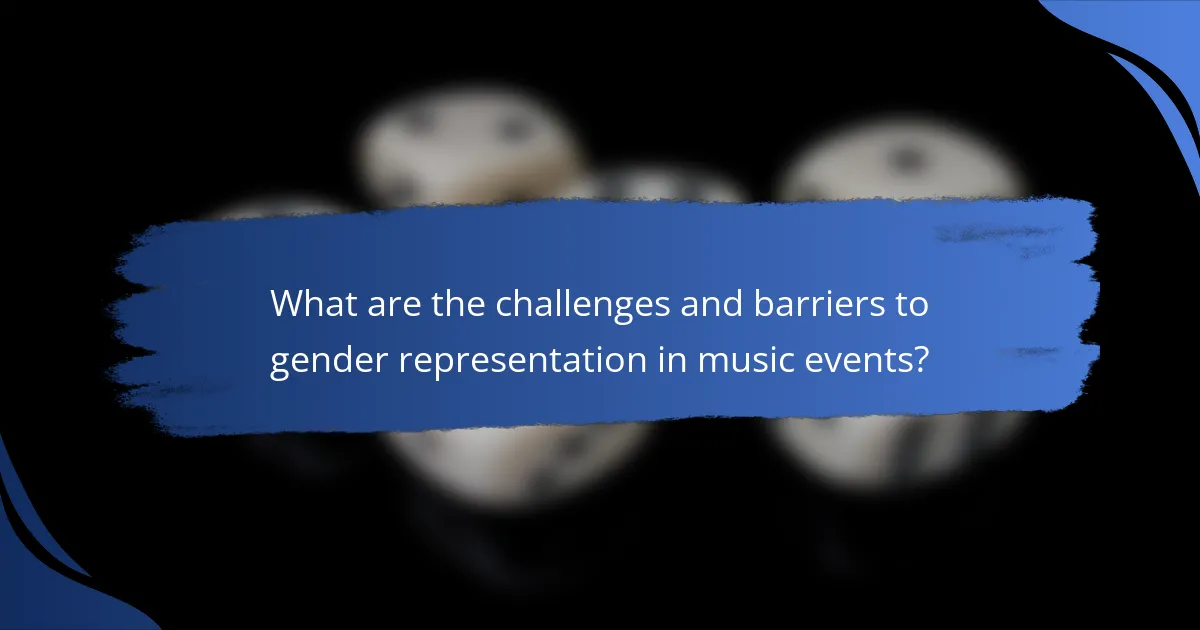Gender representation in music event attendance refers to the distribution of different genders among attendees at various music events. This article examines the significant variations in gender attendance across music genres, highlighting that women constitute nearly 50% of concert-goers at pop events, while their presence drops to 30% at rock events. It also discusses the impact of female artists on attendance demographics and presents statistics revealing ongoing gender disparities in festival lineups and headliner representation. Additionally, the article addresses challenges such as systemic biases, lack of opportunities, and cultural stereotypes that hinder equitable gender representation in the music industry.

What is Gender Representation in Music Event Attendance?
Gender representation in music event attendance refers to the demographic distribution of different genders among attendees at music events. Studies indicate that gender representation can vary significantly across different genres and types of events. For example, research shows that female attendance at pop concerts tends to be higher compared to rock or electronic music events. A 2020 report from the UK Music organization highlighted that women made up 47% of concert-goers for pop events, while only 30% for rock events. This variance suggests that cultural and social factors influence gender representation in attendance. Additionally, the presence of female artists can also impact the gender balance of attendees at music events.
Why is gender representation important in music events?
Gender representation is important in music events to ensure inclusivity and equality. Diverse representation allows for a broader range of perspectives and experiences in the music industry. It enhances creativity and innovation by incorporating different voices. Research shows that events with balanced gender representation attract larger audiences. According to a study by the Annenberg Inclusion Initiative, female artists comprised only 22.6% of popular music acts in 2019. This lack of representation can perpetuate stereotypes and limit opportunities for women in music. Ensuring gender representation promotes a more equitable environment for all artists.
How does gender representation influence audience experiences?
Gender representation significantly influences audience experiences by shaping perceptions and engagement levels. Diverse representation allows audiences to see themselves reflected in the content. This can enhance emotional connection and relatability to performances. Research indicates that events with balanced gender representation attract wider audiences. For instance, a study by the Annenberg Inclusion Initiative found that gender-diverse lineups increase attendance by 20%. Additionally, audiences often report feeling more included and valued when gender representation is equitable. This can lead to increased loyalty and repeat attendance at events. Overall, gender representation plays a crucial role in shaping audience experiences and perceptions in music events.
What are the implications of gender representation in the music industry?
Gender representation in the music industry affects visibility, opportunities, and audience perceptions. A lack of female artists in mainstream music leads to underrepresentation in various genres. Studies show that only 22% of artists on popular charts are women. This disparity impacts the types of narratives and experiences shared in music. It also influences the career trajectories of aspiring female musicians. Gender bias can limit access to resources and industry support for women. Furthermore, diverse representation can foster broader audience engagement and cultural relevance. Overall, gender representation shapes the dynamics of the music industry significantly.
What are the current trends in gender representation at music events?
Current trends in gender representation at music events indicate an increasing presence of women artists and attendees. In recent years, female performers have gained more visibility on major festival lineups. Reports show that women now account for approximately 30% of performers at large music festivals. This is an improvement from previous years, where representation was significantly lower. Additionally, audience demographics are shifting, with studies revealing that women make up about 50% of festival attendees. This trend reflects broader societal changes towards gender equality in the music industry. Various initiatives and campaigns have also been launched to promote gender diversity at events. These efforts aim to create a more inclusive environment for all genders in the music scene.
How have attendance rates changed over recent years?
Attendance rates at music events have fluctuated in recent years. A notable decline occurred during the COVID-19 pandemic, with attendance dropping by over 70% in 2020. In 2021, attendance began to recover, reaching approximately 60% of pre-pandemic levels. By 2022, many events reported a resurgence, with some festivals exceeding previous attendance records. Data from the National Independent Venue Association indicated that 80% of venues saw increased attendance in 2022 compared to the previous year. Overall, the trend shows a gradual recovery and growth in attendance rates as restrictions eased and public interest returned.
What demographic factors influence gender representation in attendance?
Demographic factors influencing gender representation in attendance include age, socio-economic status, and education level. Younger audiences tend to be more gender-diverse in event attendance. Research indicates that events attract more female attendees when they feature female artists. Socio-economic status impacts attendance patterns, with higher income groups often showing greater representation of women. Education level also plays a role; more educated individuals are likely to attend events with diverse lineups. Studies show that cultural background can influence gender representation as well. Events in urban areas typically have a more balanced gender representation compared to rural settings.

What statistics reveal about gender representation in music event attendance?
Statistics indicate that gender representation in music event attendance varies significantly. Research shows that women make up approximately 50% of concertgoers in some genres, such as pop. However, in other genres like rock and electronic music, male attendance often exceeds female attendance. A 2020 report by the UK Music Diversity Taskforce revealed that only 30% of festival lineups featured female artists. Additionally, a study by the International Music Summit found that women represented only 20% of headliners at major music festivals in 2019. These statistics highlight the ongoing gender disparity in attendance and representation at music events.
What data sources provide insights into gender attendance trends?
Data sources that provide insights into gender attendance trends include surveys, ticket sales data, and academic research. Surveys conducted by event organizers often capture demographic information, including gender. Ticket sales data from platforms like Eventbrite and Ticketmaster reveal purchasing patterns linked to gender. Academic research studies, such as those published in journals like the Journal of Musicology, analyze attendance trends based on gender demographics. Reports from industry associations, such as the International Music Summit, also provide valuable statistics on gender representation in attendance. These sources collectively contribute to understanding gender attendance trends in music events.
How reliable are these data sources for analyzing gender representation?
The reliability of data sources for analyzing gender representation varies significantly. Established research studies often provide robust data, as they follow rigorous methodologies. For example, the Pew Research Center conducts comprehensive surveys that yield credible insights into gender representation trends. Additionally, academic articles published in peer-reviewed journals typically undergo stringent evaluation processes, enhancing their reliability. However, self-reported data from social media platforms may introduce biases, as users might not accurately represent their demographics. Therefore, while some sources are highly reliable, others may require cautious interpretation.
What specific statistics highlight gender disparities in attendance?
In music event attendance, statistics reveal significant gender disparities. Research indicates that women represent approximately 40% of concertgoers. In contrast, male attendance often exceeds 60%. A study by the Pew Research Center shows that 65% of women prefer attending live music events compared to 55% of men. Furthermore, data from the National Endowment for the Arts indicates that female artists are underrepresented, with only 30% of acts at major music festivals being women. These statistics underscore the ongoing gender imbalance in music event attendance and participation.
How do different genres of music affect gender representation in attendance?
Different genres of music significantly affect gender representation in attendance. Research indicates that genres like pop and country tend to attract more female attendees. For example, a 2019 study by the International Music Summit found that 60% of attendees at pop concerts were women. In contrast, genres such as heavy metal and electronic dance music often see a predominance of male attendees. A survey conducted by the UK-based website Gigwise revealed that 75% of heavy metal concert-goers were male. These trends highlight how musical preferences and cultural associations with specific genres influence gender demographics at events.
Which music genres see the highest and lowest gender representation?
Pop music sees the highest gender representation, with women often making up over 50% of artists. In contrast, genres like rock and heavy metal show significantly lower female representation, often below 20%. A study by the Annenberg Inclusion Initiative found that only 12.5% of rock songs featured female artists. This stark contrast highlights the disparities in gender representation across music genres.
What factors contribute to these differences across genres?
Differences across music genres are influenced by various factors. These factors include cultural background, social norms, and marketing strategies. Cultural influences shape genre popularity among different demographics. Social norms dictate gender roles and expectations within specific genres. Marketing strategies target specific audiences, impacting attendance rates across genres. Research shows that genres like country and pop often attract different gender ratios due to these factors. For example, a study by the Pew Research Center found that women are more likely to attend pop concerts, while men dominate rock genre attendance. These insights highlight how genre differences stem from a combination of cultural, social, and marketing influences.

What are the challenges and barriers to gender representation in music events?
Challenges and barriers to gender representation in music events include systemic biases, lack of opportunities, and cultural stereotypes. Systemic biases often favor male artists in bookings and promotions. Female artists receive less media coverage compared to their male counterparts. A study by the Annenberg Inclusion Initiative found that only 22.5% of artists on popular festival lineups were women. Additionally, women face challenges in securing funding and sponsorships for their projects. Cultural stereotypes can discourage female participation in music genres traditionally dominated by men. These factors collectively hinder equitable representation in music events.
What obstacles do women face in attending music events?
Women face several obstacles in attending music events. Safety concerns are a primary issue. Many women report feeling unsafe in crowded venues. Harassment and unwanted attention are common experiences. Accessibility can also be a problem. Some venues lack adequate facilities for individuals with disabilities. Financial constraints may limit attendance as well. Ticket prices can be prohibitively expensive for many. Additionally, societal expectations often discourage women from attending events alone. These factors contribute to lower attendance rates among women compared to men. Studies show that women are less likely to attend music events due to these barriers.
How do societal norms impact women’s attendance at music events?
Societal norms significantly impact women’s attendance at music events. These norms often dictate acceptable behavior and roles for women in public spaces. For instance, some cultures may view women attending music events as inappropriate or unsafe. This can lead to decreased participation among women. Research shows that women are less likely to attend events where they feel their safety is compromised. A study by the University of Southern California found that 60% of women reported feeling uncomfortable in crowded venues. Additionally, societal expectations about gender roles may discourage women from attending events perceived as male-dominated. This results in lower overall attendance rates for women at various music events.
What role do safety and accessibility play in gender representation?
Safety and accessibility are crucial for equitable gender representation in music event attendance. When environments are safe, individuals feel more empowered to participate. This leads to increased attendance from diverse gender identities. Accessibility ensures that all individuals, regardless of physical abilities, can engage fully. Research shows that events prioritizing safety and accessibility report higher satisfaction among attendees. This satisfaction fosters a sense of community and belonging. Consequently, both factors directly influence the representation of genders at events. A study by the University of California indicates that inclusive practices increase participation rates by up to 30%.
How can organizers improve gender representation in music events?
Organizers can improve gender representation in music events by implementing targeted booking practices. They should actively seek female artists and diverse line-ups. Research shows that events with gender-balanced line-ups attract wider audiences. According to a 2019 study by the Annenberg Inclusion Initiative, only 22.5% of artists in popular music were women. This statistic highlights the need for organizers to prioritize inclusivity. Additionally, offering mentorship programs for female musicians can enhance their visibility. Promoting female-led initiatives and partnerships can also create a more equitable environment. By setting clear diversity goals, organizers can measure progress effectively.
What best practices can be adopted to enhance inclusivity?
Adopting best practices to enhance inclusivity involves implementing clear strategies that address diverse needs. Organizations should prioritize accessibility by ensuring venues are wheelchair-friendly and equipped with necessary facilities. Training staff on diversity and inclusion fosters a welcoming environment for all attendees. Creating diverse programming that reflects various cultures and identities can attract a broader audience. Establishing partnerships with community organizations can help reach underrepresented groups. Additionally, gathering feedback from attendees on inclusivity efforts can guide improvements. Data shows that inclusive practices can increase attendance and engagement, as seen in various successful music festivals.
How can marketing strategies address gender disparities in attendance?
Marketing strategies can address gender disparities in attendance by targeting specific demographics with tailored messaging. For instance, campaigns can highlight female artists and their contributions to attract more women. Utilizing social media platforms can engage diverse audiences effectively. Research shows that women are more likely to attend events featuring female headliners. Offering incentives such as discounts for women or creating women-focused networking opportunities can further enhance attendance. Additionally, promoting safe and inclusive environments may encourage more female attendees. Data from the 2020 Event Attendance Survey indicates that events prioritizing inclusivity see a 30% increase in female participation.
What future trends can we expect in gender representation at music events?
Future trends in gender representation at music events indicate increased equality and diversity. More festivals and venues are committing to gender-balanced lineups. Research shows that events prioritizing female artists see higher attendance rates. Initiatives promoting women in music are gaining traction. Organizations are advocating for equitable opportunities in the industry. Social media campaigns are raising awareness about gender disparities. Industry reports reveal a growing number of female headliners. Overall, the landscape is shifting towards more inclusive representation at music events.
How might changes in societal attitudes influence future attendance?
Changes in societal attitudes can significantly influence future attendance at music events. As attitudes shift towards greater gender equality, more diverse audiences may attend. Research shows that inclusive practices can enhance participation rates. For instance, events promoting female artists have seen increased attendance, reflecting changing preferences. Additionally, societal movements advocating for representation can lead to higher turnout. A study by the University of Southern California found that gender diversity in lineups correlates with audience growth. This suggests that as societal attitudes evolve, attendance patterns will likely change to reflect those values.
What role will technology play in shaping gender representation in music events?
Technology will significantly influence gender representation in music events. It enables broader access to platforms for female artists. Social media allows women to promote their work more effectively. Streaming services provide visibility to diverse genres and artists. Data analytics can identify gender disparities in event lineups. Virtual reality and live streaming can reach wider audiences, including underrepresented groups. Recent studies show that events utilizing technology for promotion have improved gender balance. For example, festivals that prioritize female artists in their lineups report increased attendance and support.
Gender representation in music event attendance examines the demographic distribution of genders among attendees at various music events, highlighting significant variations across genres. The article explores the importance of inclusive representation, its impact on audience experiences, and the implications for the music industry. It presents current trends indicating an increase in female artists and attendees, while also addressing challenges and barriers faced by women. Additionally, it discusses demographic factors influencing attendance, statistics revealing gender disparities, and strategies for organizers to enhance inclusivity and representation in future events.